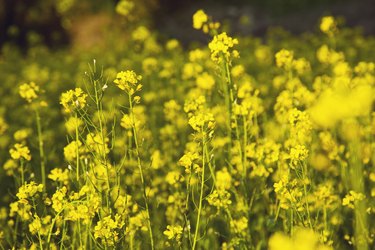
No hamburger or hotdog is complete without mustard, the tangy condiment made from ground, cracked, or whole mustard seeds. Those seeds come from a mustard plant, either Sinapis alba (white or yellow mustard) or Brassica juncea (brown or Indian mustard). Both varieties of mustard are in the Brassicaceae plant family and have clusters of four-petaled, golden-yellow flowers. The leaves of this annual can be oval, kale-like, or highly toothed, and have a spicy and pungent flavor. You may see yellow mustard flowers growing in fields as a cover crop or mustard plants growing in home gardens, where it's often used for cooking greens.
What Does a Mustard Plant Look Like?
Video of the Day

The mustard plant itself has been cultivated since 3000 BC, with Indian and Sumerian texts referencing the seed. A typical mustard plant found in a home garden will consist of large, leafy greens and golden yellow flowers growing on a stalk in clusters ranging from two to 12 flowers.
Video of the Day
The leaves are broad and flat-veined and can be toothed and lobed (meaning the leaves of the mustard plant may not be smooth on the sides). They're usually dark green, but mustard plant leaves can also have purple streaks and appear curly or smooth.
What Does a Mustard Seed Look Like?
Mustard seeds are known for being tiny. They're the subject of parables and praise since the humble, small mustard seed grows into a large mustard tree or mustard bush in Palestine and African regions, inspiring great things from small beginnings. The mustard seed is around one-tenth of an inch in size.
A mustard plant will grow long, skinny seed pods. Sometimes colored black, purple, or green, the mustard seed pods split in the middle to expose small, light yellow, white, or dark brown seeds, depending on the plant type. White or yellow mustard seeds that are typically grown in gardens will be white or light yellow like their flowers. B. juncea will have around 20 brown mustard seeds in each pod, while white mustard plants will have around eight seeds per pod. A related plant, B. nigra, produces black mustard seeds that are used as a spice. Black mustard is a common weed in the U.S. but not typically cultivated for table mustard because it is more challenging to mechanically harvest.
Mustard Plant vs. Mustard Bush
It should be noted that a mustard bush is a very different plant altogether. Found in Africa, the mustard bush isn't the same as the mustard plant that provides seeds for a condiment or can be found in a small American garden.
The African mustard bush feeds livestock and is used for medicinal purposes. It can grow up to 13 feet tall with a 20-foot spread of leaves. While some may refer to their smaller, garden-grown mustard plants as a mustard bush due to its size and shape, the official mustard bush is a very different plant that's usually not suited for home gardens.
Are Mustard Plants Edible?
The entire mustard plant can be used as a food source. Mustard leaves (and shoots) can be eaten as a vegetable dish, much like spinach leaves. (These are sometimes called mustard greens or leaf mustard.) Mustard greens can grow in cooler temperatures and can be cut from the plant individually without harvesting the entire plant at once. Even mustard flowers are edible, although they can be very bitter and not as tasty as the leaves and, therefore, not used as often as a food source. The mustard seed can be used fresh as a spice or dried and ground to make a mustard condiment.